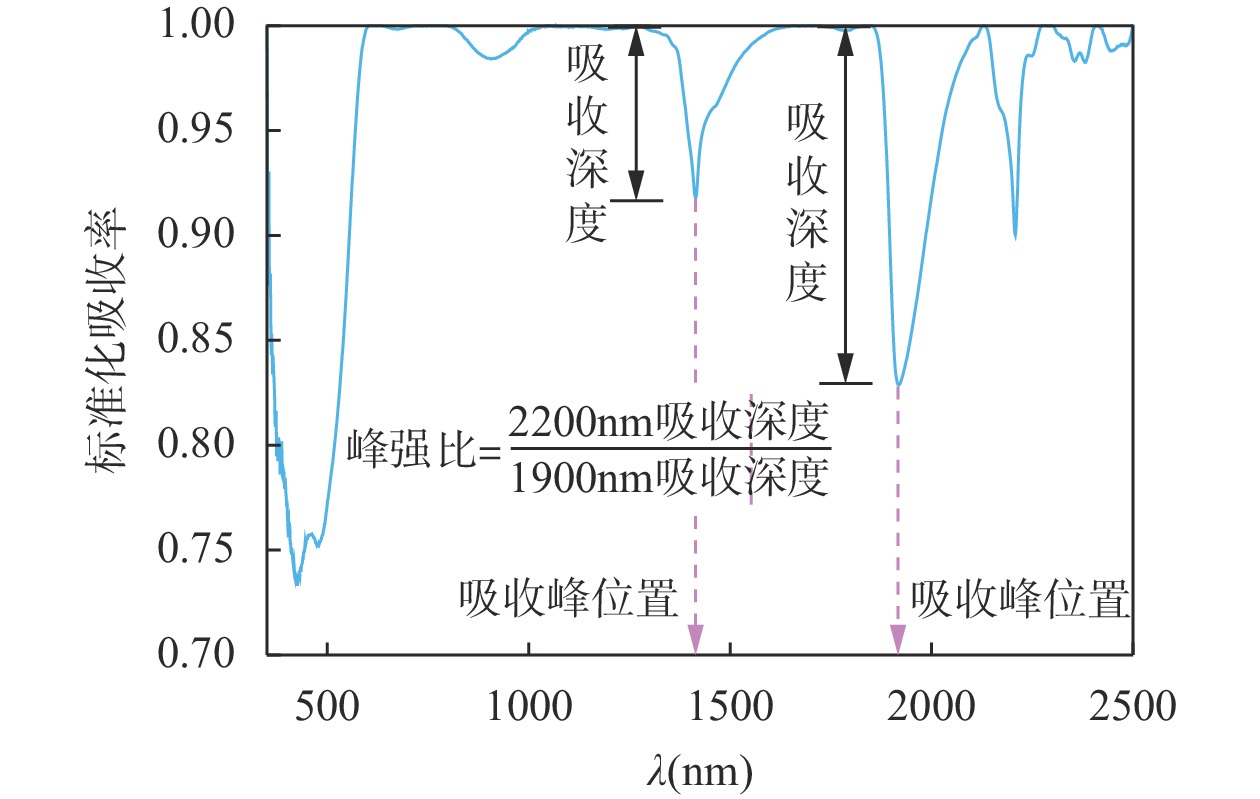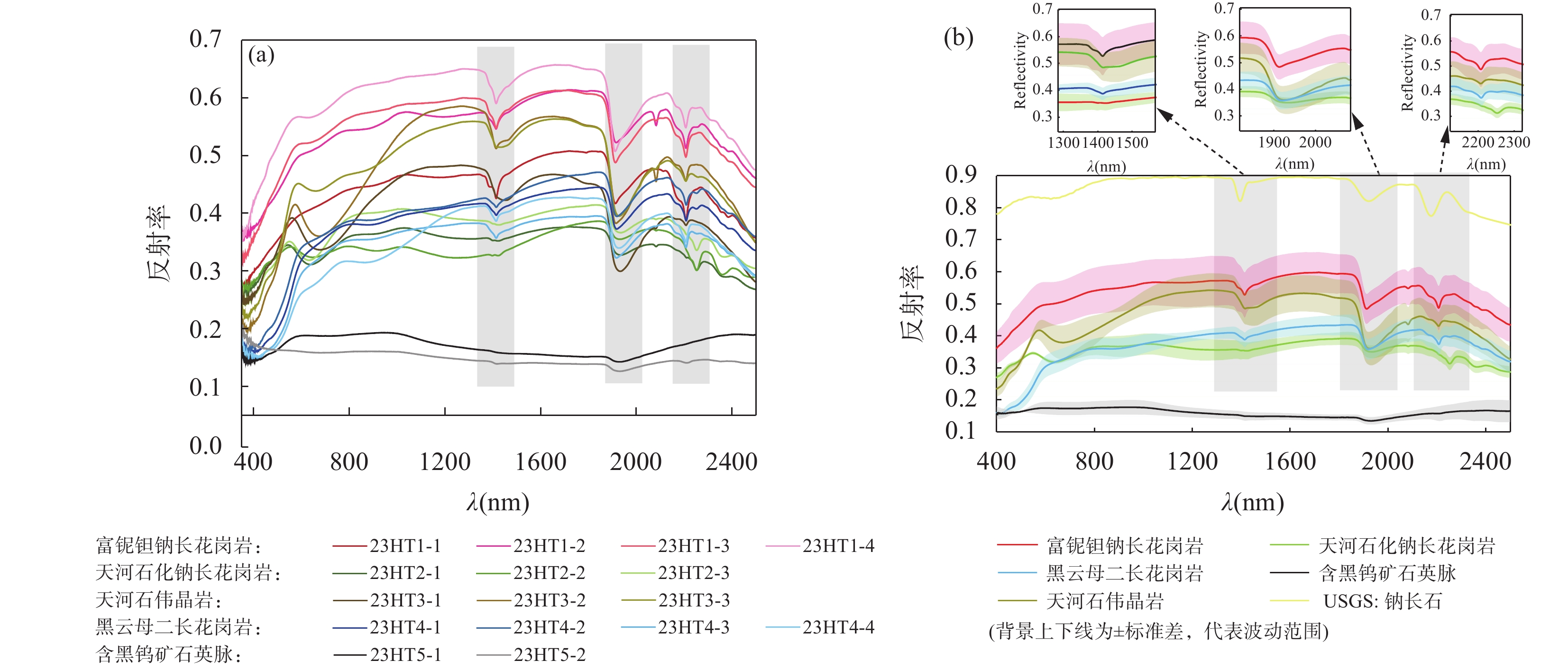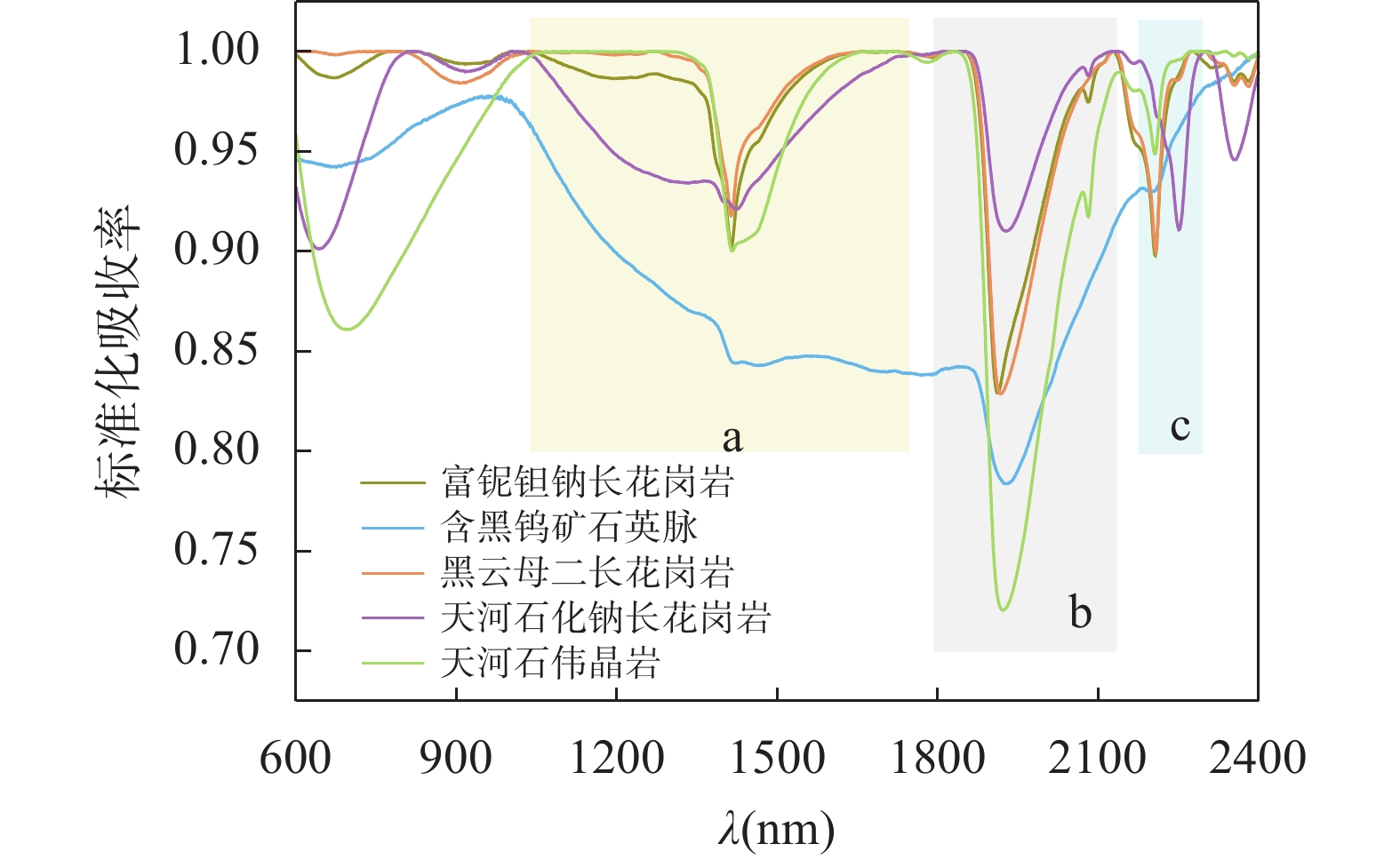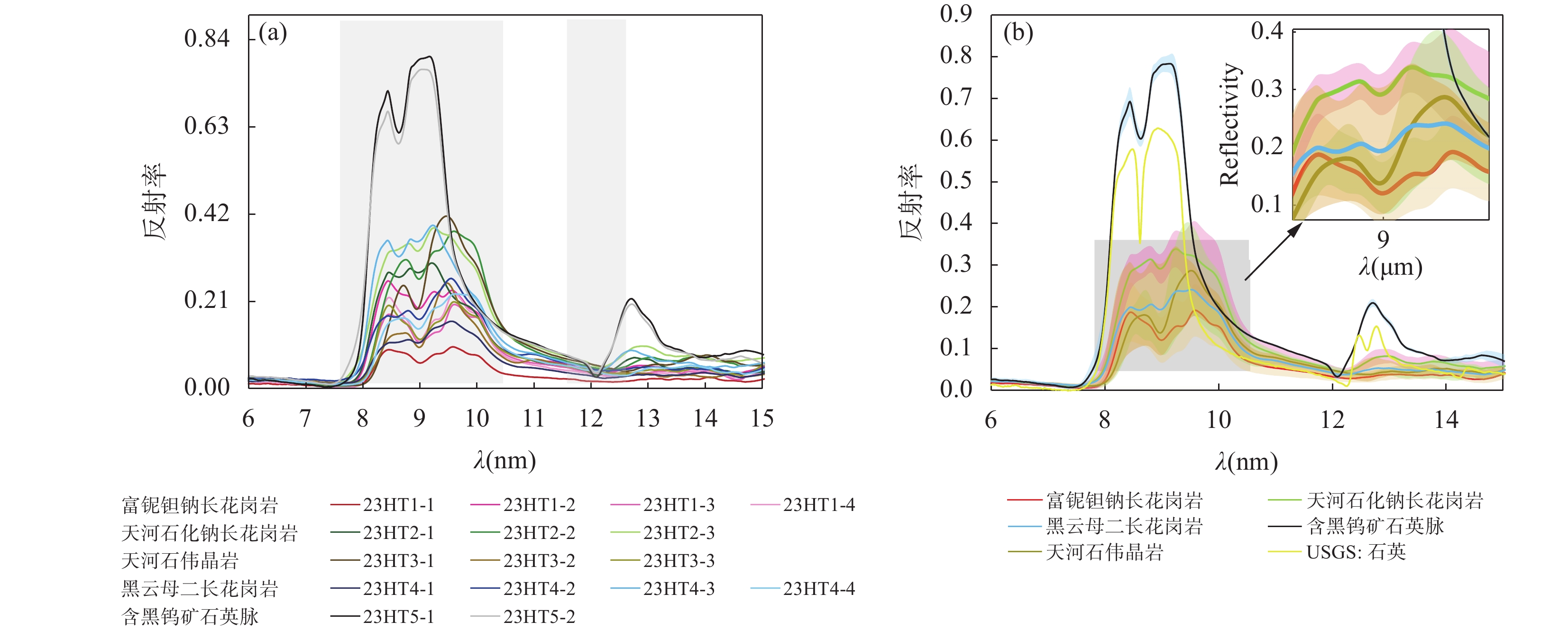Spectral Identification Characteristics of Typical Rocks and Minerals in Alkali Feldspar Granite Type Nb-Ta Deposits in Central Inner Mongolia
-
摘要:
内蒙古中部地区,位于大兴安岭南段—华北陆块北缘成矿带,因其碱长花岗岩型铌钽矿的广泛分布而备受关注。尽管该地区铌钽矿资源丰富,但对其光谱学特征的系统认识尚不足,在一定程度上制约了矿产资源勘查的精确性和效率。本文以赵井沟大型铌钽矿床为例,利用便携式短波红外及热红外光谱仪对赵井沟典型岩矿样本开展光谱测量与分析,揭示富铌钽钠长花岗岩、天河石化钠长花岗岩、天河石伟晶岩、黑云母二长花岗岩、含黑钨矿石英脉波谱特征,并对其展开对比研究。研究表明:在近红外光谱范围内,与USGS光谱库中的标准钠长花岗岩光谱进行对比分析,发现2360nm处的弱吸收特征可作为天河石化钠长花岗岩与其他岩石及矿物区分的关键波段,此差异推测可能由岩石的蚀变矿化过程引起。在热红外光谱分析中,含黑钨矿石英脉因其显著的高反射率和“三峰”特征而易于区分与识别。尽管富铌钽钠长花岗岩、天河石伟晶岩和黑云母二长花岗岩在光谱形态上具有一定的相似性,但它们在2200nm附近的吸收深度的大小和峰强比的差异,为有效地区分这些矿物提供了重要依据。
要点(1)天河石化钠长花岗岩在2360nm附近有独特的弱吸收特征,可作为区分标志。
(2)含黑钨矿石英脉在热红外光谱中显示高反射率和“三峰”特征,尤其是在8μm至10μm波长区域内,可据此准确鉴别。
(3)富铌钽钠长花岗岩、天河石伟晶岩及黑云母二长花岗岩虽谱形相似,但可通过2200nm附近的吸收深度、峰强比进行区分。
HIGHLIGHTS(1) Amazonitization albite granite exhibits a unique weak absorption feature near 2360nm, distinguishing it from other minerals.
(2) Quartz veins containing wolframite display high reflectance and “three-peak” features in the thermal infrared spectrum, particularly between 8μm to 10μm, facilitating precise identification.
(3) Despite their similar spectral shapes, Nb-Ta enriched albite granite, amazonite pegmatite, and biotite monzogranite can be distinguished by the absorption depth and the ratio of absorption peak intensity around 2200nm.
Abstract:Located in the central region of Inner Mongolia, within the southern segment of the Daxing’anling-North China Craton metallogenic belt, the area is notable for its widespread distribution of alkaline granite-type niobium-tantalum (Nb-Ta) deposits. Despite the region’s rich Nb-Ta resources, a comprehensive understanding of its spectroscopic characteristics remains inadequate, hindering precise and efficient mineral exploration. This study focuses on the Zhaojinggou large Nb-Ta deposit, employing portable short-wave infrared and thermal infrared spectrometers to analyze typical rock and mineral samples. The research reveals distinctive spectroscopic features of Nb-Ta enriched albite granite, amazonitization albite granite, amazonite pegmatite, biotite monzogranite, and wolframite-quartz vein. Comparative analysis, particularly against the standard sodium granite spectrum from the USGS spectral library, identifies a specific weak absorption feature at 2360nm, crucial for distinguishing amazonitization albite granite from other rocks and minerals, likely attributed to rock alteration and mineralization processes. In thermal infrared spectroscopy, quartz veins containing wolframite are distinguished by their high reflectance and “three-peak” features. Despite their similar spectral shapes, Nb-Ta enriched albite granite, amazonite pegmatite, and biotite monzogranite can be distinguished by the absorption depth and the ratio of absorption peak intensity around 2200nm. These findings provide a foundational dataset for future remote sensing surveys and evaluations of Nb-Ta mineral resources. The BRIEF REPORT is available for this paper at http://www.ykcs.ac.cn/en/article/doi/10.15898/j.ykcs.202401090001.
-
Keywords:
- Nb-Ta deposits /
- spectral characteristic parameters /
- near-infrared spectroscopy /
- thermal infrared spectroscopy
BRIEF REPORTSignificance: Niobium (Nb) and tantalum (Ta) are rare refractory metals with crucial and unique properties essential for technological advancements across multiple industries[1-3]. However, China has long faced shortages in the supply of rare metals such as Nb and Ta. Despite previous exploration efforts, the resources often have low grades, making economic beneficiation challenging and resulting in many resources becoming “fallow ores” that are difficult to utilize[4-5]. Given the current situation, there is an urgent need to enhance research on the exploration, development, and utilization of these critical mineral resources to meet the demand for rare metals driven by economic development. Infrared spectroscopy technology excels in identifying and extracting alteration mineral types in mineral deposits. Based on characteristic spectral changes of typical alteration minerals, this technology can be used to accurately track mineralization centers and construct efficient spectral survey models. These models provide scientific and reliable guidance for further exploration in the region, enabling geological surveyors to more accurately locate potential ore deposits and improve exploration efficiency. However, current spectral understanding of alkaline granite-type Nb-Ta deposits characteristics such as Tianhe petrochemical granite and sodic granite, as well as wall-rock alteration features, remains relatively weak and requires further research.
The Zhaojinggou deposit is a large rare metal deposit primarily consisting of Nb-Ta discovered in recent years in the central part of Inner Mongolia, where co-occurring tungsten ores also hold significant economic value[18-19]. Influenced by multiple phases of tectonic magmatic activity, mineral-bearing hydrothermal fluids in the area have overlaid and transformed rock bodies, making it extremely challenging to distinguish and classify hydrothermal alteration zones. Although the hydrothermal alteration zones in the Zhaojinggou deposit do not exhibit distinct zonation characteristics, there is a close spatial relationship between alkaline petrochemical and Nb-Ta mineralization zones[20-21]. Therefore, in this study, alkaline granite veins with prominent exposure conditions and identification features of rare metal content are researched to obtain spectral characteristic information of different geological bodies and typical minerals in the study area. This will provide a spectral basis for future remote sensing geological exploration of the region and lay a theoretical foundation for remote sensing surveys of rare metals in the area.
Methods: This field sampling involved a total of 16 points, covering the main veins in the Zhaojinggou area. Sixteen samples were collected. A portable field spectrometer (CSD350) was used for near-infrared spectrum analysis, covering the wavelength range of 350 to 2500nm with spectral resolutions of 3−4nm@(350−950nm) and 7−10nm@(950−2500nm). Thermal infrared spectroscopy was conducted using a portable Fourier transform infrared spectrometer (Agilent 4300 Handel FTIR), covering the wavelength range of 4000−650cm-1 (2.5−15.37μm) with a spectral resolution of 4cm−1. Following established methods and considering the complex mineral composition, all spectral measurements were conducted indoors. Three collection points were selected on the fresh surface of each sample, with 5 spectral curves collected per point. In the absence of errors or anomalies, the arithmetic average of 15 spectral reflectance curves was used as the final spectral reflectance. Additionally, the spectrometer was calibrated every 10min to ensure accuracy and stability, thereby enhancing the precision and reliability of the experimental data[17, 24].
Continuous wavelet transform was used to enhance the original spectra, effectively highlighting features within the spectral curves and reducing the influence of noise[25-28]. Three key spectral parameters (absorption peak position, absorption depth, and the ratio of absorption peak intensity) were selected to reveal mineral characteristics.
Data and Results: In the spectral range of 350−2500nm and 6000−15000nm, the original and average spectra of rock and mineral samples (Fig.3a, Fig.5a), sodium feldspar spectra from the USGS library (Fig.3b, Fig.5b) and continuous wavelet transform spectra (Fig.4, Fig.6) were compared to explore the spectral heterogeneity of typical rock minerals in Zhaojinggou area. Nb-Ta enriched albite granite, amazonite pegmatite, and biotite monzogranite exhibit significant and similar absorption features in specific wavelength regions; in contrast, amazonitization albite granite shows lower and smoother reflectance, while wolframite-quartz veins exhibit distinct low reflectance and lack prominent absorption features in the near-infrared spectral range, distinguishing it from other samples. From Fig.4 and Table 2, differences in absorption depth at 2200nm (Nb-Ta enriched albite granite>biotite monzogranite>amazonitization albite granite>amazonite pegmatite) and the ratio of absorption peak intensity (amazonitization albite granite>Nb-Ta enriched albite granite>biotite monzogranite>wolframite-quartz vein>biotite monzogranite) distinguish rock minerals. Additionally, amazonitization albite granite exhibits unique optical characteristics in spectral analysis, specifically a noticeable weak absorption feature near the 2360nm wavelength, which can aid in identifying amazonitization albite granite.
Based on the region’s emissivity levels, wolframite-quartz veins are accurately identified, which exhibit high reflectance and a distinctive “triple peak” feature in the 8−15μm range, distinguishing them clearly from other minerals and rocks[28]. The thermal infrared spectra of Nb-Ta enriched albite granite, amazonitization albite granite, amazonite pegmatite, and biotite monzogranite are similar, with lower reflectance and “double peak” features. From Fig.6 and Table 3, it is evident that wolframite-quartz veins exhibit high absorption spectral features at 12μm, clearly differentiated from other minerals and rocks. Meanwhile, although Nb-Ta enriched albite granite, amazonitization albite granite, amazonite pegmatite, and biotite monzogranite have similar spectral shapes, they can still be distinguished by reflectance magnitude and specific absorption feature parameters at certain wavelengths.
-
铌(Nb)和钽(Ta)作为稀有难熔金属[1],具有非常重要且独特的性质,是多个行业现代技术进步和发展所需的非常关键的金属[2-3]。然而,中国长期以来在铌和钽等稀有金属方面存在供应短缺的问题,尽管过去有过一些勘探成果,但往往资源品位较低,难以进行经济有效地选冶,导致许多资源实质上成为了“呆矿”,即难以利用的资源[4-5]。基于当前的情况,亟需加强对这些关键矿产资源的勘查与开发利用研究,以满足经济发展对稀有金属的需求。
铌和钽在自然界中经常共存于各种矿物中,不仅含量较低,而且往往与其他氧化物杂质共存,使得其开发和提取过程变得极其困难。矿物蚀变作为铌钽等稀有金属找矿的重要指示标志之一,其鉴定和分析对于提高找矿效率和准确性具有重要意义。相较于传统的蚀变矿物鉴定,主要依靠野外肉眼观察、镜下光薄片鉴定和X射线衍射分析,存在工作效率低、成本高、细粒矿物难以区分等难题,而短波红外光谱勘查技术因便携、无损且对含水、含羟基矿物识别准确而广受应用,尤其是广泛应用于斑岩型、火山成因块状硫化物型(VMS)、浅成低温热液型、矽卡岩型等矿床[6-10]。6000~15000nm的热红外光谱对石英、辉石、钠长石、微斜长石等矿物展现出显著的识别特性,该技术已被地质学家广泛应用于不同类型的岩石分析,特别是矽卡岩型、伟晶岩型和斑岩型岩石的鉴别和研究。而且岩矿光谱信息已成功应用在地质解译及成矿预测等研究中[11-17]。因此,红外光谱技术在识别与提取矿床中的蚀变矿物类型方面表现出色。该技术基于典型蚀变矿物的特征波谱变化,能够精确地追踪矿化中心,并据此构建出高效的光谱勘查模型,这些模型为区域内的进一步找矿勘探工作提供了科学且可靠的指导依据,地质勘探人员能够更为精准地定位潜在矿床,提高找矿效率。但是目前对铌钽矿区的天河石化花岗岩、钠长石化花岗岩矿化特征、围岩蚀变特征的波谱认识还较为薄弱,需要进一步加强研究。
赵井沟矿床是近年来在内蒙古中部地区发现的一处以铌钽为主的大型稀有金属矿床,同时在同一空间内共生的钨矿也有较高的经济价值[18-19]。受多期次构造岩浆作用的影响,该区域含矿热液流体对岩体的叠加改造作用致使热液蚀变带的辨别和划分都十分困难。虽然赵井沟矿区热液蚀变不具有明显分带特征,但是碱长石化与铌钽矿化带存在密切空间分布关系[20-21]。基于此,本文将出露条件和识别特征较为明显的含稀有金属钠长花岗岩脉作为目标,获取研究区域不同地质体和典型矿物的波谱特征信息,为今后开展该地区的遥感地质找矿研究提供波谱依据,也为该地区稀有金属的遥感调查评价奠定理论基础。
1. 地质概况
赵井沟铌钽矿位于华北克拉通北缘中段乌拉山—大青山的东部地区,临河—集宁断裂带的南缘。区域构造活动强烈,呈现早期以韧性剪切带为特征,晚期以脆性断裂和推覆构造为特点的构造格局[21]。区内近东西向断裂为主干断裂,控制区域地层、岩浆岩的分布北东和北西向断裂构造也较为发育,长几千米到十几千米。矿区的地层主要发育有中元古界渣尔泰山群、石炭系拴马桩组和第四系。如图1所示,渣尔泰山群广泛分布于矿区的南部区域,其岩性特征鲜明,主要包括黑灰色片理化变质砂岩、灰 绿色千枚岩和浅褐黄色石英岩。此外,栓马庄组与渣尔泰山群之间呈现为明显的断层接触关系,岩性为灰绿色、杂色轻变质砾岩、灰褐色、杂色轻变质粗砂岩和灰黄色轻变质粉砂岩。
![]() 图 1 内蒙古赵井沟钽铌矿矿区地质图及典型手标本及镜下图[21](a)富铌钽钠长花岗岩被后期天河石脉穿插,同时发育浸染状细粒天河石;(b)铌钽矿体围岩深灰色变质含砾粗砂岩,被灰白色细粒钠长花岗岩脉切穿;(c)富铌钽钠长花岗岩被后期天河石脉穿插,同时发育浸染状细粒天河石和立方体黄铁矿; (d)天河石伟晶岩围岩;(e)灰白色细粒含铌钽钠长花岗岩,黄绿色蚀变细脉穿插;(f)灰白色富铌钽细粒钠长花岗岩夹天河石细脉;(g)萤石化天河石化伟晶岩; (h)萤石化天河石化伟晶岩;(i)细粒黑云母钠长花岗岩中发育的天河石化伟晶岩;(j)钾化黑云母二长花岗岩,零星分布少量细粒铌铁矿。Figure 1. Geological map, typical hand specimens, and microscopic images of the Zhaojinggou tantalum-niobium deposit in Inner Mongolia[21]
图 1 内蒙古赵井沟钽铌矿矿区地质图及典型手标本及镜下图[21](a)富铌钽钠长花岗岩被后期天河石脉穿插,同时发育浸染状细粒天河石;(b)铌钽矿体围岩深灰色变质含砾粗砂岩,被灰白色细粒钠长花岗岩脉切穿;(c)富铌钽钠长花岗岩被后期天河石脉穿插,同时发育浸染状细粒天河石和立方体黄铁矿; (d)天河石伟晶岩围岩;(e)灰白色细粒含铌钽钠长花岗岩,黄绿色蚀变细脉穿插;(f)灰白色富铌钽细粒钠长花岗岩夹天河石细脉;(g)萤石化天河石化伟晶岩; (h)萤石化天河石化伟晶岩;(i)细粒黑云母钠长花岗岩中发育的天河石化伟晶岩;(j)钾化黑云母二长花岗岩,零星分布少量细粒铌铁矿。Figure 1. Geological map, typical hand specimens, and microscopic images of the Zhaojinggou tantalum-niobium deposit in Inner Mongolia[21]近矿围岩浅部为石炭系栓马桩组的黑灰色轻变质含砾砂岩,深部主要为石英闪长岩和花岗岩。矿体蚀变较强,主要有钠长石化、天河石化及云英岩化,在矿体蚀变的同时近矿围岩也存在不同程度的钠长石化、天河石化及云英岩化现象。区内脉岩大体可分花岗细晶岩脉、含钨石英脉、含天河石化钠长花岗岩脉和含天河石花岗伟晶岩四类(图1),其中,在研究区内钠长石化天河石花岗岩脉中广泛发育铌钽矿物,一般均达工业品位要求,其对铌钽矿物的形成具有指示作用[18-20]。
2. 实验部分
2.1 样品采集与制备
针对赵井沟铌钽矿体,本文开展了系统的矿石采集工作。重点关注钠长花岗岩型、天河石化钠长花岗岩型以及天河石伟晶岩型三种典型矿石类型,这些矿石类型在赵井沟矿体中占据重要地位。为更全面地了解矿体的地质特征,在与赵井沟共生的马房子钨矿区采集了石英脉型黑钨矿石。这些矿石的采集不仅有助于分析矿体的共生关系,还能提供更多关于矿石成因和矿化作用的信息。
本次野外采样共计 16个点,基本覆盖了赵井沟地区的主要矿脉,共采集样品16件,采样点的位置如图1所示,具体岩性见表1。这些样品不仅代表了区域内的主要岩石/矿物构成,还体现了矿体及近矿围岩的蚀变特征。为确保光谱测量的准确性,避免样品表面杂质成分对测量结果产生不利影响,在光谱测量之前,对样品进行擦拭处理。
表 1 典型岩矿石样品信息Table 1. Information of typical rock samples样品编号 岩性 样品类型 样品编号 岩性 样品类型 23HT1-1 富铌钽钠长花岗岩 地表样品 23HT3-2 天河石伟晶岩 地表样品 23HT1-2 富铌钽钠长花岗岩 地表样品 23HT3-3 天河石伟晶岩 地表样品 23HT1-3 富铌钽钠长花岗岩 地表样品 23HT4-1 黑云母二长花岗岩 地表样品 23HT1-4 富铌钽钠长花岗岩 地表样品,发育天河石伟晶岩细脉 23HT4-2 黑云母二长花岗岩 地表样品 23HT2-1 天河石化钠长花岗岩 地表样品 23HT4-3 黑云母二长花岗岩 地表样品 23HT2-2 天河石化钠长花岗岩 地表样品 23HT4-4 黑云母二长花岗岩 地表样品 23HT2-3 天河石化钠长花岗岩 地表样品 23HT5-1 含黑钨矿石英脉 地表样品 23HT3-1 天河石伟晶岩 地表样品 23HT5-2 含黑钨矿石英脉 地表样品 2.2 波谱数据采集
光谱测试是一种非破坏性的分析技术,其波长范围的界定与使用是基于矿物物理化学性质相关的振动模式集群而定的,并非受限于仪器或测量条件。1300~1850nm主要受到羟基相关拉伸振动基频的影响;1850~2600nm主要被基本拉伸和弯曲振动的OH组合带以及与CO3相关的拉伸基频的组合所主导[22];5500~15000nm主要受到Si—O键的收缩振动的影响,进而产生特定的吸收特征[23]。通过对这些特征谱段进行解读,有助于对矿物的种类、结构和成分进行准确判别。
通过测量赵井沟地区铌钽矿床中典型矿物标本的近红外与热红外光谱数据,系统分析和解读这些光谱特征,以期能够总结出一套具有实际应用价值的基础光谱数据集。该数据集将直接服务于本类型矿床的遥感地质调查与研究工作,为快速、准确地识别典型矿物提供一种无损且高效的手段。
根据便携程度,光谱测试仪器现阶段大致可划分为便携式和大型台式两类。在本次实验中,近红外波谱测量使用便携式地物波谱仪(CSD350),波谱范围在350~2500nm,波谱分辨率:3~4nm@(350~950nm)、7~10nm@(950~2500nm);热红外波谱测量使用便携式傅里叶变换红外波谱仪(Agilent 4300 Handel FTIR),波谱范围在4000~650cm−1之间(2.5~15.37μm),波谱分辨率为4cm−1。参考前人做法并考虑矿物组合复杂的实际情况,波谱数据测量均在室内进行。在每个样本的新鲜面处取3个采集点,每个采集点采集5条波谱曲线,在无错误或异常情况下,则取15条波谱曲线反射率的算术平均值作为最终的波谱反射率。此外,通过测量间隔10min对光谱仪进行定标,可以确保光谱仪的准确性和稳定性,从而提高实验测试数据的精度和可靠性[17,24]。
2.3 光谱变换与特征参数提取
2.3.1 光谱变换
在光谱数据的采集过程中,由于测量仪器性能、环境条件、样本特性等多种因素的影响,原始光谱数据中往往包含噪声信息,这会对后续的矿物分类识别工作造成干扰。为了克服这些困难,研究者们经常采用各种光谱变换技术来提高数据的质量和分类性能。其中,连续统去除法(包络线去除,或称为基线校正、连续统归一化)是一种常用的光谱增强技术,它能够有效地突出光谱曲线中的特征,并减少噪声的影响[25-28]。
2.3.2 光谱特征参数提取
在光谱分析领域,光谱特征参数提取扮演着至关重要的角色。这一技术不仅广泛应用于植被和土壤研究,以准确追踪其不同阶段的信息变化,为生态环境监测和农业管理提供有力支持[29-30],而且在矿产勘探和开发方面也展现出其独特的价值,特别是用于量化矿物特征[31-32]。本文将该技术进一步聚焦于矿产勘探领域,通过深入分析光谱数据来揭示矿物的特性。为此,选取了三个关键的光谱特征参数[33],这些参数可以提供关于矿物成分、结构和形成过程的关键信息,示意图见图2。
(1)吸收峰位置:即光谱特征峰的吸收位置。用特征峰反射率最小处(也就是吸收深度最大处)所对应的波长值来表示。具体的吸收位置因所含元素的不同会发生一定的位移。
(2)吸收深度:通常指的是在特定波长范围内,矿物对光的吸收程度,即在某波段吸收范围内,反射率最低点到归一化包络线的位置(吸收深度=1−连续统去除反射率)。吸收深度可以反映矿物的相对含量以及蚀变强弱。例如,如果某种矿物在特定波长下具有较深的吸收峰,那么这可能意味着该矿物在样品中的含量较高,或者该矿物经历较强的蚀变作用。
(3)峰强比:指矿物吸收峰强度之比,是矿物特征峰的深度与其水吸收峰的深度的比值。该参数可以反映矿物的结晶度。一般来说, 峰强比值较高通常表示矿物的结晶度较好,意味着矿物在更高的温度下形成。
3. 分析与讨论
3.1 350~2500nm波谱特征分析与特征识别
3.1.1 350~2500nm波谱特征
根据光谱测量结果,本文对比了富铌钽钠长花岗岩、天河石化钠长花岗岩、天河石伟晶岩、黑云母二长花岗岩、含黑钨矿石英脉等矿物及岩石在350~2500nm的原始光谱(图3a)、同属性样品光谱平均值代表及USGS光谱库中的钠长石光谱数据(图3b),探索赵井沟地区典型岩石矿物在350~2500nm光谱异质性。当使用350~2500nm分析岩石样品时,每种岩性在近红外光谱中展现出独特的吸收和反射特征。富铌钽钠长花岗岩、天河石伟晶岩以及黑云母二长花岗岩在特定波长区域显示出显著且相似的吸收特征;相较之下,天河石化钠长花岗岩表现出较低且平缓的反射率,而含黑钨矿石英脉在近红外波谱范围内则表现出明显的低反射率且缺乏明显吸收特征,使其与其他样品明显区分。
![]() 图 3 (a)典型岩矿近红外原始光谱; (b)典型岩矿近红外原始光谱平均值(背景上下线为±标准差, 代表波动范围)及USGS光谱库钠长石光谱Figure 3. (a) Near-infrared raw spectra of typical rocks and minerals; (b) Average near-infrared raw spectra of typical rocks and minerals (shaded area represents±standard deviation, indicating the range of variation), along with the USGS spectral library spectra of albite.
图 3 (a)典型岩矿近红外原始光谱; (b)典型岩矿近红外原始光谱平均值(背景上下线为±标准差, 代表波动范围)及USGS光谱库钠长石光谱Figure 3. (a) Near-infrared raw spectra of typical rocks and minerals; (b) Average near-infrared raw spectra of typical rocks and minerals (shaded area represents±standard deviation, indicating the range of variation), along with the USGS spectral library spectra of albite.具体波谱特征分别如下。
(1)富铌钽钠长花岗岩总体反射率在580~2250nm光谱区间内保持较高趋势,整体反射率在0.7以下,在1414、1912和2208nm处存在明显吸收特征。
(2)天河石化钠长花岗岩总体反射率中等且较为平缓,在646、1932、2252和2366nm附近存在吸收特征,但不明显。
(3)天河石伟晶岩在整体反射率中等,在0.7以下,在1929nm处存在非常明显的吸收特征,同时在1445nm附近有一稍明显吸收特征,在670nm和2208nm处存在不明显的吸收特征。
(4)黑云母二长花岗岩在整体反射率偏低,在0.5以下,在1921nm附近存在非常明显的吸收特征,在2209nm处存在次级吸收特征,在2251nm处存在一不明显吸收特征。
(5)含黑钨矿石英脉整体上反射率较低,在0.2以下,波谱比较平缓,没有明显的特征吸收。
3.1.2 350~2500nm连续统去除光谱及特征参数分析
为了更清晰地观测矿物的特征光谱,本文对350~2500nm原始光谱数进行连续统去除处理(图4)。并基于连续统去除处理结果对三个特征参数进行提取,结果列于表2。通过对近红外连续统去除光谱分析,可根据弱吸特征及吸收峰处的反射率、吸收深度和吸收带宽等参数的微妙差异帮助区分不同岩石和矿物。
表 2 赵井沟主要岩石及矿物连续统去除光谱特征参数Table 2. Characteristic parameters of continuum removal of the main rocks and minerals in Zhaojingou岩性 吸收峰的位置P(nm) 吸收深度D 峰强比
ICa b c a b c 富铌钽钠长花岗岩 1414 1912 2207 0.098 0.171 0.102 0.60 天河石化钠长花岗岩 1424 1928 2251 0.079 0.090 0.089 0.99 天河石伟晶岩 1415 1922 2206 0.100 0.280 0.051 0.18 黑云母二长花岗岩 1414 1918 2208 0.082 0.171 0.100 0.58 含黑钨矿石英脉 1770 1930 2130 0.162 0.216 0.087 0.40 从图4可知,通过2200nm处的吸收深度差异(富铌钽钠长花岗岩>黑云母二长花岗岩>天河石化钠长花岗岩>天河石伟晶岩)、峰强比差异(天河石化钠长花岗岩>富铌钽钠长花岗岩>黑云母二长花岗岩>含黑钨矿石英脉>天河石伟晶岩)来区分岩石矿物。特别地,峰强比的差异可以深入剖析岩石结晶时的环境条件,即峰强比值越高,矿物的结晶度越好,表明形成时的温度越高[33]。天河石化钠长花岗岩的峰强比值最高,表明其在形成过程中经历了高温条件下或频繁的岩浆热液活动,对矿物的最终形成具有重要影响。值得注意的是,研究发现峰强比值的高低与铌、钽等稀有元素的矿化水平呈正相关。即,随着峰强比值的增加,铌、钽的富集程度显著增加。这一发现与现有文献中的观点相吻合,即钠长石化的强烈程度是促进铌、钽等元素富集的关键因素[18-20,34]。这一关系加深了天河石化钠长花岗岩形成机制的理解,并为探索稀有金属元素在地壳中的分布与富集机制提供了新的理论视角和实证依据。
此外,天河石化钠长花岗岩在光谱分析中展现出独特的光学特性,即在2360nm波长附近存在一个明显的弱吸收特征(图3、图4)。这一特征不仅显著区别于其他矿物,也为天河石化钠长花岗岩的识别与分类提供了可靠的标志。通过这一特征,可以有效地将天河石化钠长花岗岩与其他矿物及岩石类型区分开来。值得注意的是,图3b显示USGS光谱库中的钠长花岗岩光谱数据(Albite)在2360nm处并无吸收特征,因此,推测出此处差异可能是由于蚀变矿化引起的。
结合前人对岩石矿物的光谱研究,1400、1900及2200nm处的特征峰分别对应H2O和OH—的混合吸收、H2O吸收以及Al—OH的特定振动模式,反映了这些岩石中水和羟基的存在[33,35]。900nm的特征峰与岩性样品中可能含有Fe2+、Fe3+有关[36]。同时,2360nm 附近的诊断特征可能与羟基、Fe2+ 和碳酸根及其复合谱带的吸收作用有关,或者是由于随着OH基团被Fe2+取代而向更长的波长移动的结果[37]。另一方面,Fe2+氧化为Fe3+的过程中,不仅会形成铁的氧化物和氢氧化物,还能标识含金属热液活动及其氧化环境[38]。因此,该特征可作为探索露头矿藏、理解地质氧化过程的重要线索和标志。
需要注意的是,基于近红外光谱特征描述得知1400nm和1900nm谱段附近是重要波段范围,但其也是大气中水汽的吸收波段,因此这将是地面光谱应用到航空、航天高光谱遥感工作中需要注意的问题。总体来看,利用2360nm附近的弱吸收特征可以帮助识别天河石化钠长花岗岩。同时,通过分析2200nm处的吸收深度和吸收带宽,可以有效地区分赵井沟地区其他典型的岩石和矿物。
3.2 6000~15000nm波谱特征分析及特征识别
3.2.1 6000~15000nm波谱特征
根据光谱测量结果,本文对比了富铌钽钠长花岗岩、天河石化钠长花岗岩、天河石伟晶岩、黑云母二长花岗岩、含黑钨矿石英脉等矿物及岩石在6000~15000nm原始光谱数据(图5a)、同属性样品光谱平均值代表及USGS光谱库中的石英光谱数据(图5b),探索赵井沟地区典型岩石矿物在6000~15000nm波谱异质性。每种岩石类型在热红外光谱范围内展现出独特的波谱特性,其中,根据该区域内发射率的高低和明显的“三峰”特征,准确地鉴别出含黑钨矿石英脉,其在8~15μm波段有高反射率和独特指纹,与其他矿物岩石区别明显[28]。富铌钽钠长花岗岩、天河石化钠长花岗岩、天河石伟晶岩以及黑云母二长花岗岩的热红外谱形相似,反射率均偏下且均存在“双峰”特征。尽管这四类矿物岩石光谱相似,但通过反射率和特定波长吸收峰位置的差异可实现有效地区分。
![]() 图 5 (a)典型岩矿热红外原始光谱; (b)典型岩矿热红外原始光谱平均值(背景上下线为±标准差,代表波动范围)及USGS光谱库石英光谱Figure 5. (a) Thermal infrared raw spectra of typical rocks and minerals; (b) Average thermal infrared raw spectra of typical rocks and minerals (shaded area represents±standard deviation, indicating the range of variation), along with the USGS spectral library spectra of quartz
图 5 (a)典型岩矿热红外原始光谱; (b)典型岩矿热红外原始光谱平均值(背景上下线为±标准差,代表波动范围)及USGS光谱库石英光谱Figure 5. (a) Thermal infrared raw spectra of typical rocks and minerals; (b) Average thermal infrared raw spectra of typical rocks and minerals (shaded area represents±standard deviation, indicating the range of variation), along with the USGS spectral library spectra of quartz具体波谱特征分别如下。
(1)富铌钽钠长花岗岩反射率整体偏下,在0.4以下。主要在8463nm和9581nm附近存在吸收峰,在9003nm附近存在较为明显的吸收谷。有吸收“双峰”特征,分别在8463nm和9581nm处。在9003nm处存在较为明显的吸收谷。
(2)天河石化钠长花岗岩反射率整体偏下,在0.4以下。在8463nm前存在明显上升的陡坡;9203~9546nm区间内存在明显下降的陡坡;8972nm处有较缓吸收谷。12876nm处有宽缓吸收特征。
(3)天河石伟晶岩反射率整体偏下,在0.4以下。反射率吸收存在“双峰”特征,分别在8622nm和9463nm附近。在8987nm处存在较为明显的吸收谷。
(4)黑云母二长花岗岩反射率整体趋势一致,在7698nm处存在明显上升的陡坡;反射率吸收呈现“双峰”特征,在9000nm附近有宽缓吸收特征;在12806nm处存在吸收峰。
(5)含黑钨石英脉波谱特征清晰,石英石成分起主导作用,相比较于其他样品,该样品波谱反射率较高,反射率整体偏高,在0.8以下;在8410nm和9018nm处呈现吸收“双峰”特征;在7515nm处存在明显上升陡坡;在12085nm处存在吸收谷而后又明显上升,在12685nm有一处明显吸收峰。这一系列的光谱变化构成了含黑钨石英脉波谱的“三峰”特征。
3.2.2 6000~15000nm连续统去除光谱及特征参数分析
为了进一步探索观测矿物的特征光谱,本文对原始热红外光谱进行连续统去除处理(图6)。并基于连续统去除处理结果对吸收位置和吸收深度参数进行提取,结果如表3所示。在热红外光谱范围内对原始热红外光谱进行连续统去除处理后,区分效果并不如原始光谱明显,但通过特征参数的细微差距仍能实现区分。
表 3 赵井沟主要岩石及矿物连续统去除光谱特征参数Table 3. Characteristic parameters of continuum removal for the main rocks and minerals in Zhaojingou岩性 吸收峰的位置P(nm) 吸收深度D a b a b 富铌钽钠长花岗岩 7.52 12.25 0.978 0.800 天河石化钠长花岗岩 7.44 12.11 0.974 0.788 天河石伟晶岩 7.70 12.45 0.964 0.778 黑云母二长花岗岩 7.50 12.14 0.955 0.766 含黑钨矿石英脉 7.36 12.09 0.989 0.924 从图6及表3可以看出,5种矿物的热红外区域的光谱吸收特征大致分为两部分。a区的吸收深度相差很小,误差在±0.03;吸收位置为:天河石伟晶岩>富铌钽钠长花岗岩>黑云母二长花岗岩>天河石化钠长花岗岩>含黑钨矿石英脉。b区的吸收特征参数差异性明显些,在12μm附近,含黑钨矿石英脉与其他4种矿物具有明显的区分标志,其吸收深度明显大于其余4种矿物,且吸收位置最小。
总体来看,基于热红外光谱分析,含黑钨矿石英脉在12μm处显示出高吸收的波谱特征,与其他矿物及岩石有清晰区分。同时,富铌钽钠长花岗岩、天河石化钠长花岗岩、天河石伟晶岩以及黑云母二长花岗岩虽谱形相似,但仍可通过反射率大小和特定波长下的吸收特征参数进行区分。
4. 结论
通过对赵井沟地区5种主要岩石及矿物(富铌钽钠长花岗岩、天河石化钠长花岗岩、天河石伟晶岩、黑云母二长花岗岩、含黑钨矿石英脉)的原始近红外光谱和热红外光谱进行详尽分析,采用连续统去除处理技术突出了矿物的特征光谱,并基于处理结果提取了关键的特征参数。主要结论如下:在近红外波段,经与USGS波谱库中标准钠长石对比,天河石化钠长花岗岩在2360nm附近存在的弱吸收特征,是赵井沟铌钽矿区的岩石矿物区分的重要标志。含黑钨矿石英脉在近红外和热红外光谱中均显示出独特的波谱特征,与其他矿物及岩石有明显区分。同时,尽管富铌钽钠长花岗岩、天河石伟晶岩以及黑云母二长花岗岩的谱形特征具有相似性,但可通过2200nm附近的吸收特征参数进行有效地区分。
然而,本文仍存在一定的局限性,主要是光谱与矿化之间的定量分析。特别是针对天河石化钠长花岗岩,后续尝试建立其与矿化程度之间的定量关系模型,为找矿工作提供更为精确的指导。
-
图 1 内蒙古赵井沟钽铌矿矿区地质图及典型手标本及镜下图[21]
(a)富铌钽钠长花岗岩被后期天河石脉穿插,同时发育浸染状细粒天河石;(b)铌钽矿体围岩深灰色变质含砾粗砂岩,被灰白色细粒钠长花岗岩脉切穿;(c)富铌钽钠长花岗岩被后期天河石脉穿插,同时发育浸染状细粒天河石和立方体黄铁矿; (d)天河石伟晶岩围岩;(e)灰白色细粒含铌钽钠长花岗岩,黄绿色蚀变细脉穿插;(f)灰白色富铌钽细粒钠长花岗岩夹天河石细脉;(g)萤石化天河石化伟晶岩; (h)萤石化天河石化伟晶岩;(i)细粒黑云母钠长花岗岩中发育的天河石化伟晶岩;(j)钾化黑云母二长花岗岩,零星分布少量细粒铌铁矿。
Figure 1. Geological map, typical hand specimens, and microscopic images of the Zhaojinggou tantalum-niobium deposit in Inner Mongolia[21]
图 3 (a)典型岩矿近红外原始光谱; (b)典型岩矿近红外原始光谱平均值(背景上下线为±标准差, 代表波动范围)及USGS光谱库钠长石光谱
Figure 3. (a) Near-infrared raw spectra of typical rocks and minerals; (b) Average near-infrared raw spectra of typical rocks and minerals (shaded area represents±standard deviation, indicating the range of variation), along with the USGS spectral library spectra of albite.
图 5 (a)典型岩矿热红外原始光谱; (b)典型岩矿热红外原始光谱平均值(背景上下线为±标准差,代表波动范围)及USGS光谱库石英光谱
Figure 5. (a) Thermal infrared raw spectra of typical rocks and minerals; (b) Average thermal infrared raw spectra of typical rocks and minerals (shaded area represents±standard deviation, indicating the range of variation), along with the USGS spectral library spectra of quartz
表 1 典型岩矿石样品信息
Table 1 Information of typical rock samples
样品编号 岩性 样品类型 样品编号 岩性 样品类型 23HT1-1 富铌钽钠长花岗岩 地表样品 23HT3-2 天河石伟晶岩 地表样品 23HT1-2 富铌钽钠长花岗岩 地表样品 23HT3-3 天河石伟晶岩 地表样品 23HT1-3 富铌钽钠长花岗岩 地表样品 23HT4-1 黑云母二长花岗岩 地表样品 23HT1-4 富铌钽钠长花岗岩 地表样品,发育天河石伟晶岩细脉 23HT4-2 黑云母二长花岗岩 地表样品 23HT2-1 天河石化钠长花岗岩 地表样品 23HT4-3 黑云母二长花岗岩 地表样品 23HT2-2 天河石化钠长花岗岩 地表样品 23HT4-4 黑云母二长花岗岩 地表样品 23HT2-3 天河石化钠长花岗岩 地表样品 23HT5-1 含黑钨矿石英脉 地表样品 23HT3-1 天河石伟晶岩 地表样品 23HT5-2 含黑钨矿石英脉 地表样品 表 2 赵井沟主要岩石及矿物连续统去除光谱特征参数
Table 2 Characteristic parameters of continuum removal of the main rocks and minerals in Zhaojingou
岩性 吸收峰的位置P(nm) 吸收深度D 峰强比
ICa b c a b c 富铌钽钠长花岗岩 1414 1912 2207 0.098 0.171 0.102 0.60 天河石化钠长花岗岩 1424 1928 2251 0.079 0.090 0.089 0.99 天河石伟晶岩 1415 1922 2206 0.100 0.280 0.051 0.18 黑云母二长花岗岩 1414 1918 2208 0.082 0.171 0.100 0.58 含黑钨矿石英脉 1770 1930 2130 0.162 0.216 0.087 0.40 表 3 赵井沟主要岩石及矿物连续统去除光谱特征参数
Table 3 Characteristic parameters of continuum removal for the main rocks and minerals in Zhaojingou
岩性 吸收峰的位置P(nm) 吸收深度D a b a b 富铌钽钠长花岗岩 7.52 12.25 0.978 0.800 天河石化钠长花岗岩 7.44 12.11 0.974 0.788 天河石伟晶岩 7.70 12.45 0.964 0.778 黑云母二长花岗岩 7.50 12.14 0.955 0.766 含黑钨矿石英脉 7.36 12.09 0.989 0.924 -
[1] 尹兆波, 高利坤, 饶兵. 我国铌矿资源概况及选矿技术进展[J]. 矿产保护与利用, 2024, 44(1): 115−125. doi: 10.13779/j.cnki.issn1001-0076.2024.01.013 Yin Z B, Gao L K, Rao B. Overview of niobium resources and progress in mineral processing technology in China[J]. Conservation and Utilization of Mineral Resources, 2024, 44(1): 115−125. doi: 10.13779/j.cnki.issn1001-0076.2024.01.013
[2] 曹飞, 杨卉芃, 张亮, 等. 全球钽铌矿产资源开发利用现状及趋势[J]. 矿产保护与利用, 2019, 39(5): 56−67, 89. doi: 10.13779/j.cnki.issn1001-0076.2018.06.041 Cao F, Yang H P, Zhang L, et al. Current situation and trend analysis of global tantalum and niobium mineral resources[J]. Conservation and Utilization of Mineral Resources, 2019, 39(5): 56−67, 89. doi: 10.13779/j.cnki.issn1001-0076.2018.06.041
[3] Ma J, Guo X, Xue H, et al. Niobium/tantalum-based materials: Synthesis and applications in electrochemical energy storage[J]. Chemical Engineering Journal, 2020, 380: 122428. doi: 10.1016/j.cej.2019.122428
[4] 王登红. 关键矿产的研究意义、矿种厘定、资源属性、找矿进展、存在问题及主攻方向[J]. 地质学报, 2019, 93(6): 1189−1209. doi: 10.19762/j.cnki.dizhixuebao.2019186 Wang D H. Study on critical mineral resources: Significance of research, determination of types, attributes of resources, progress of prospecting, problems of utilization, and direction of exploitation[J]. Acta Geologica Sinica, 2019, 93(6): 1189−1209. doi: 10.19762/j.cnki.dizhixuebao.2019186
[5] 李建康, 李鹏, 王登红, 等. 中国铌钽矿成矿规律[J]. 科学通报, 2019, 64(15): 1545−1566. doi: 10.1360/N972018-00933 Li J K, Li P, Wang D H, et al. A review of niobium and tantalum metallogenic regularity in China[J]. Chinese Science Bulletin, 2019, 64(15): 1545−1566. doi: 10.1360/N972018-00933
[6] 徐清俊, 叶发旺, 张川, 等. 基于高光谱技术的钻孔岩心蚀变信息研究: 以新疆白杨河铀矿床为例[J]. 东华理工大学学报(自然科学版), 2016, 39(2): 184−190. doi: 10.3969/j.issn.1674-3504.2016.02.013 Xu Q J, Ye F W, Zhang C, et al. Alteration information of drill core in Baiyanghe uranium deposit, Xinjiang using hyperspectral technology[J]. Journal of East China Institute of Technology (Natural Science), 2016, 39(2): 184−190. doi: 10.3969/j.issn.1674-3504.2016.02.013
[7] Dehnavi S, Maghsoudi Y, Valadanzoej M. Using spectrum differentiation and combination for target detection of minerals[J]. International Journal of Applied Earth Observation and Geoinformation, 2017, 55: 9−20. doi: 10.1016/j.jag.2016.10.005
[8] 张弘, 高卿楠, 郭东旭. 花岗伟晶岩型锂矿热红外反射光谱特征及锂元素定量反演研究[J]. 矿物岩石, 2021, 41(1): 25−31. doi: 10.19719/j.cnki.1001-6872.2021.01.03 Zhang H, Gao Q N, Guo D X. Thermal infrared reflectance spectral characteristics of granitic pegmatite type lithium ore and quantitative inversion of lithium element[J]. Mineralogy and Petrology, 2021, 41(1): 25−31. doi: 10.19719/j.cnki.1001-6872.2021.01.03
[9] Cardoso-Fernandes J, Silva J, Perrotta M M, et al. Interpretation of the reflectance spectra of lithium (Li) minerals and pegmatites: A case study for mineralogical and lithological identification in the Fregeneda—Almendra area[J]. Remote Sensing, 2021, 13(18): 3688.
[10] 成嘉伟, 刘新星, 张娟, 等. 河北邯邢地区白涧铁矿蚀变矿物红外光谱分析及找矿研究[J]. 地球科学, 2023, 48(4): 1551−1567. doi: 10.3799/dqkx.2022.303 Cheng J W, Liu X X, Zhang J, et al. Infrared spectral analysis and prospecting of alteration minerals of Baijian skarn-type iron deposit in Han—Xing area[J]. Earth Science, 2023, 48(4): 1551−1567. doi: 10.3799/dqkx.2022.303
[11] 吴泽群, 田淑芳. 利用热红外遥感提取层状硅酸盐蚀变矿物信息研究——以甘肃北山地区为例[J]. 西北地质, 2016, 49(1): 241−248. doi: 10.3969/j.issn.1009-6248.2016.01.025 Wu Z Q, Tian S F. Application of thermal infrared remote sensing in the extraction of altered phyllosilicate minerals: Example from Beishan area of Gansu Province[J]. Northwestern Geology, 2016, 49(1): 241−248. doi: 10.3969/j.issn.1009-6248.2016.01.025
[12] 田丰, 孙雨, 赵英俊, 等. 航空热红外高光谱在岩性识别中的应用——以甘肃柳园地区TASI数据为例[J]. 世界核地质科学, 2023, 40(3): 863−873. doi: 10.3969/j.issn.1672-0636.2023.03.017 Tian F, Sun Y, Zhao Y J, et al. Application of airborne thermal infrared hyperspectroscopy in lithology identification: A case study of TASI data in Liuyuan, Gansu[J]. World Nuclear Geoscience, 2023, 40(3): 863−873. doi: 10.3969/j.issn.1672-0636.2023.03.017
[13] 田丰. 全波段(0.35~25μm)高光谱遥感矿物识别和定量化反演技术研究[D]. 北京: 中国地质大学(北京), 2010. Tian F. Identification and quantitative retrival of minerals information integrating VIS-NIR-MIR-TIR (0.35-25μm) hyspectral data[D]. Beijing: China University of Geosciences (Beijing), 2010.
[14] Wan Y, Fan Y, Jin M. Application of hyperspectral remote sensing for supplementary investigation of polymetallic deposits in Huaniushan ore region, Northwestern China[J]. Scientific Reports, 2021, 11(1): 440. doi: 10.1038/s41598-020-79864-0
[15] 郭东旭, 张弘, 高卿楠, 等. 钻孔岩心红外光谱-便携式XRF-磁化率测试在攀西太和钒钛磁铁矿床勘查中的应用[J]. 岩矿测试, 2022, 41(1): 43−53. doi: 10.3969/j.issn.0254-5357.2022.1.ykcs202201005 Guo D X, Zhang H, Gao Q N, et al. Infrared spectroscopy, portable XRF and magnetic susceptibility analysis of drill core for exploration of the Taihe vanadium Titano—Magnetite deposit in the Panxi area, Sichuan Province[J]. Rock and Mineral Analysis, 2022, 41(1): 43−53. doi: 10.3969/j.issn.0254-5357.2022.1.ykcs202201005
[16] Xie B, Mao W, Peng B, et al. Thermal-infrared spectral feature analysis and spectral identification of monzonite using feature-oriented principal component analysis[J]. Minerals, 2022, 12: 508. doi: 10.3390/min12050508
[17] 赵龙贤, 代晶晶, 林彬, 等. 西藏甲玛3000 m深钻蚀变矿物短波-热红外光谱特征[J]. 地质学报, 2023, 97(4): 1342−1359. doi: 10.3969/j.issn.0001-5717.2023.04.022 Zhao L X, Dai J J, Lin B, et al. Short- wave- thermal infrared spectra characteristics of altered minerals from the Jiama 3000m deep drill in Tibet[J]. Acta Geologica Sinica, 2023, 97(4): 1342−1359. doi: 10.3969/j.issn.0001-5717.2023.04.022
[18] 聂凤军, 王丰翔, 赵宇安, 等. 内蒙古赵井沟大型铌钽矿床地质特征及成因[J]. 矿床地质, 2013, 32(4): 730−743. doi: 10.3969/j.issn.0258-7106.2013.04.007 Nie F J, Wang F X, Zhao Y A, et al. Geological features and origin of Zhaojinggou Nb-Ta deposit in Wuchuan County, Inner Mongolia[J]. Mineral Deposits, 2013, 32(4): 730−743. doi: 10.3969/j.issn.0258-7106.2013.04.007
[19] 鄂阿强. 内蒙古中部典型花岗岩型稀有金属矿床特征和控矿因素[J]. 有色金属科学与工程, 2018, 9(2): 62−69. doi: 13264/j.cnki.ysjskx.2018.02.011 E A Q. Ore characteristics and ore controlling factors of rare metal deposits of typical granite type in the middle of the Inner Mongolia Autonomous Region[J]. Nonferrous Metals Science and Engineering, 2018, 9(2): 62−69. doi: 13264/j.cnki.ysjskx.2018.02.011
[20] 李志丹, 李效广, 崔玉荣, 等. 内蒙古赵井沟铌钽矿床燕山期成矿: 来自LA-MC-ICP-MS独居石、锆石U-Pb和黑云母40Ar-39Ar年龄的证据[J]. 地球科学, 2019, 44(1): 234−247. doi: 10.3799/dqkx.2018.100 Li Z D, Li X G, Cui Y R, et al. Yanshanian mineralization of Zhaojinggou Nb-Ta deposit, Inner Mongolia: Evidences from the monazite and zircon LA-MC-ICP-MS U-Pb and biotite 40Ar-39Ar Geochronology[J]. Earth Science, 2019, 44(1): 234−247. doi: 10.3799/dqkx.2018.100
[21] 高允, 孙艳, 赵芝, 等. 内蒙古武川县赵井沟铌钽多金属矿床白云母40Ar-39Ar同位素年龄及地质意义[J]. 岩矿测试, 2017, 36(5): 551−558. doi: 10.15898/j.cnki.11-2131/td.201612290190 Gao Y, Sun Y, Zhao Z, et al. 40Ar-39Ar Dating of muscovite from the Zhaojinggou Nb-Ta polymetallic deposit in Wuchuan County of Inner Mongolia and its geological implications[J]. Rock and Mineral Analysis, 2017, 36(5): 551−558. doi: 10.15898/j.cnki.11-2131/td.201612290190
[22] Clark R N, King T V V, Klejwa M, et al. High spectral resolution reflectance spectroscopy of minerals[J]. Journal of Geophysical Research: Solid Earth, 1990, 95(B8): 12653−12680. doi: 10.1029/JB095iB08p12653
[23] Sitarz M, Handke M, Mozgawa W. Identification of silicooxygen rings in SiO2 based on IR spectra[J]. Spectrochimica Acta Part A: Molecular and Biomolecular Spectroscopy, 2000, 56(9): 1819−1823. doi: 10.1016/S1386-1425(00)00241-9
[24] 回广骥, 高卿楠, 宋利强, 等. 新疆可可托海稀有金属矿床矿物和岩石热红外光谱特征[J]. 岩矿测试, 2021, 40(1): 134−144. doi: 0.15898/j.cnki.11-2131/td.202005060001 Hui G J, Gao Q N, Song L Q, et al. Thermal infrared spectra characteristics of rare metal minerals and rock in the Keketuohai deposit, Xijiang[J]. Rock and Mineral Analysis, 2021, 40(1): 134−144. doi: 0.15898/j.cnki.11-2131/td.202005060001
[25] 翟文羽, 陈磊, 徐艺轩, 等. 利用光谱吸收深度定量反演碳酸盐矿物的影响因素及应用分析[J]. 光谱学与光谱分析, 2021, 41(7): 2226−2232. doi: 10.3964/j.issn.1000-0593(2021)07-2226-07 Zhai W Y, Chen L, Xu Y X. et al. Analysis of impact factors and applications by using spectral absorption depth for quantitative inversion of carbonate mineral[J]. Spectroscopy and Spectral Analysis, 2021, 41(7): 2226−2232. doi: 10.3964/j.issn.1000-0593(2021)07-2226-07
[26] Bai J, Li X, Hu X, et al. Classification methods of the hyperspectral image based on the continuum-removed[J]. Computer Engineering & Applications, 2003, 4897: 325−329. doi: 10.1117/12.466729
[27] Gomez C, Lagacherie P, Coulouma G. Continuum removal versus PLSR method for clay and calcium carbonate content estimation from laboratory and airborne hyperspectral measurements[J]. Geoderma, 2008, 148(2): 141−148. doi: 10.1016/j.geoderma.2008.09.016
[28] 代晶晶, 赵龙贤, 姜琪, 等. 热红外高光谱技术在地质找矿中的应用综述[J]. 地质学报, 2020, 94(8): 2520−2533. doi: 10.3969/j.issn.0001-5717.2020.08.026 Dai J J, Zhao L X, Jiang Q, et al. Review of thermal-infrared spectroscopy applied in geological ore exploration[J]. Acta Geologica Sinica, 2020, 94(8): 2520−2533. doi: 10.3969/j.issn.0001-5717.2020.08.026
[29] 李志, 苏武峥, 李新国, 等. 基于高光谱特征参数优选的土壤盐分含量建模及其验证[J]. 新疆农业科学, 2021, 58(12): 2342. doi: 10.6048/j.issn.1001-4330.2021.12.022 Li Z, Su W Z, Li X G, et al. Modeling and verification of soil salt content based on hyperspectral characteristic parameter optimization[J]. Xinjiang Agricultural Sciences, 2021, 58(12): 2342. doi: 10.6048/j.issn.1001-4330.2021.12.022
[30] 王惠敏, 谭琨, 武复宇, 等. 基于光谱吸收特征的土壤重金属反演及吸附机理研究[J]. 光谱学与光谱分析, 2020, 40(1): 316−323. doi: 10.3964/j.issn.1000-0593(2020)01-0316-08 Wang H M, Tan K, Wu F Y, et al. Study of the retrieval and adsorption mechanism of soil heavy metals based on spectral absorption characteristics[J]. Spectroscopy and Spectral Analysis, 2020, 40(1): 316−323. doi: 10.3964/j.issn.1000-0593(2020)01-0316-08
[31] 邱佳炜, 刘新星, 薛哲, 等. 湖北金银山锑矿蚀变矿物红外光谱特征及找矿应用[J]. 岩石矿物学杂志, 2024, 43(3): 776−786. doi: 10.20086/j.cnki.yskw.2024.0321 Qiu J W, Liu X X, Xue Z, et al. Infrared spectroscopic characteristics and prospecting applications of altered minerals in the Jinyinshan antimony deposit in Hubei Province[J]. Acta Petrologica et Mineralogica, 2024, 43(3): 776−786. doi: 10.20086/j.cnki.yskw.2024.0321
[32] 王珊珊, 周可法, 白泳, 等. 新疆镜儿泉伟晶岩型锂矿岩矿光谱特征分析[J]. 地学前缘, 2023, 30(5): 205−215. doi: 10.13745/j.esf.sf.2023.5.19 Wang S S, Zhou K F, Bai Y, et al. Spectral reflectance study of the Jing’erquan pegmatite lithium deposit, Xinjiang[J]. Earth Science Frontiers, 2023, 30(5): 205−215. doi: 10.13745/j.esf.sf.2023.5.19
[33] 田丰, 冷成彪, 张兴春, 等. 短波红外光谱技术在矿床勘查中的应用[J]. 矿物岩石地球化学通报, 2019, 38(3): 634−642. doi: 10.19658/j.issn.1007-2802.2019.38.042 Tian F, Leng C B, Zhang X C, et al. Application of short wavelength infrared technique in exploration of mineral deposits: A review[J]. Bulletin of Mineralogy, Petrology and Geochemistry, 2019, 38(3): 634−642. doi: 10.19658/j.issn.1007-2802.2019.38.042
[34] 李雪, 王可勇, 孙国胜, 等. 内蒙古赵井沟钽铌矿床成矿作用探讨——来自天河石化、钠长石化花岗岩年代学、岩石地球化学的证据[J]. 岩石学报, 2021, 37(6): 1765−1784. doi: 10.18654/1000-0569/2021.06.08 Li X, Wang K Y, Sun G S, et al. Discussion on metallogenesis of Zhaojinggou Ta-Nb deposit in Inner Mongolia: Evidence from amazonitization and albitization granite geochronology and geochemistry[J]. Acta Petrologica Sinica, 2021, 37(6): 1765−1784. doi: 10.18654/1000-0569/2021.06.08
[35] LeGras M, Laukamp C, Lau I, et al. NVCL spectral reference library-phyllosilicates Part 2: Micas[R]. Canberra: Commonwealth Scientific and Industrial Research Organisation, 2018.
[36] Mekonenn S A. Spectral analysis of lithium-bearing micas with shortwave and longwave infrared spectroscopy[D]. Holland: University of Twente, 2023.
[37] Laukamp C, Rodger A, LeGras M, et al. Mineral physicochemistry underlying feature-based extraction of mineral abundance and composition from shortwave, mid and thermal infrared reflectance spectra[J]. Minerals, 2021, 11(4): 347. doi: 10.3390/min11040347
[38] 申俊峰, 李胜荣, 杜柏松, 等. 金矿床的矿物蚀变与矿物标型及其找矿意义[J]. 矿物岩石地球化学通报, 2018, 37(2): 157−167. doi: 10.19658/j.issn.1007-2802.2018.37.018 Shen J F, Li S R, Du B S, et al. Minerals alteration and typomorph in gold deposit and their implications for prospecting[J]. Bulletin of Mineralogy, Petrology and Geochemistry, 2018, 37(2): 157−167. doi: 10.19658/j.issn.1007-2802.2018.37.018




 下载:
下载:





 京公网安备 11010202008159号
京公网安备 11010202008159号